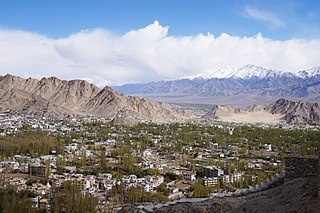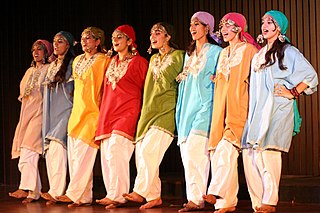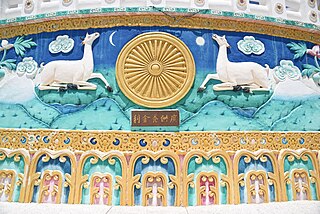
Ladakh is a region administered by India as a union territory and constitutes an eastern portion of the larger Kashmir region that has been the subject of a dispute between India and Pakistan since 1947 and India and China since 1959. Ladakh is bordered by the Tibet Autonomous Region to the east, the Indian state of Himachal Pradesh to the south, both the Indian-administered union territory of Jammu and Kashmir and the Pakistan-administered Gilgit-Baltistan to the west, and the southwest corner of Xinjiang across the Karakoram Pass in the far north. It extends from the Siachen Glacier in the Karakoram range to the north to the main Great Himalayas to the south. The eastern end, consisting of the uninhabited Aksai Chin plains, is claimed by the Indian Government as part of Ladakh, but has been under Chinese control.

Leh is a city in Indian-administered Ladakh in the disputed Kashmir region. It is the largest city and the joint capital of Ladakh. Leh, located in the Leh district, was also the historical capital of the Kingdom of Ladakh. The seat of the kingdom, Leh Palace, the former residence of the royal family of Ladakh, was built in the same style and about the same time as the Potala Palace in Tibet. Since they were both constructed in a similar style and at roughly the same time, the Potala Palace in Tibet and Leh Palace, the royal residence, are frequently contrasted. Leh is at an altitude of 3,524 m (11,562 ft), and is connected via National Highway 1 to Srinagar in the southwest and to Manali in the south via the Leh-Manali Highway.

Kargil district is a district in Indian-administered Ladakh in the disputed Kashmir-region, which is administered as a union territory of Ladakh. It is named after the city of Kargil, where the district headquarters lies. The district is bounded by the Indian-administered union territory of Jammu and Kashmir to the west, the Pakistani-administered administrative territory of Gilgit–Baltistan to the north, Ladakh's Leh district to the east, and the Indian state of Himachal Pradesh to the south. Encompassing three historical regions known as Purig, Dras and Zanskar, the district lies to the northeast of the Great Himalayas and encompasses the majority of the Zanskar Range. Its population inhabits the river valleys of the Dras, Suru, Wakha Rong, and Zanskar.

Leh district is a district in Indian-administered Ladakh in the disputed Kashmir-region. Ladakh is an Indian-administered union territory. With an area of 45,110 km2, it is the second largest district in the country, second only to Kutch. It is bounded on the north by Gilgit-Baltistan's Kharmang and Ghanche districts and Xinjiang's Kashgar Prefecture and Hotan Prefecture, to which it connects via the historic Karakoram Pass. Aksai Chin and Tibet are to the east, Kargil district to the west, and Lahul and Spiti to the south. The district headquarters is in Leh. It lies between 32 and 36 degree north latitude and 75 to 80 degree east longitude.

Kargil or Kargyil is a city in Indian-administered Ladakh in the Kashmir region. It is the joint capital of Ladakh, an Indian-administered union territory. It is also the headquarters of the Kargil district. It is the second-largest city in Ladakh after Leh. Kargil is located 204 kilometres (127 mi) east of Srinagar in Jammu and Kashmir, and 234 kilometres (145 mi) to the west of Leh. It is on the bank of the Suru River near its confluence with the Wakha Rong river, the latter providing the most accessible route to Leh.

Kashmiris are an Indo-Aryan ethnolinguistic group speaking the Kashmiri language and originating from the Kashmir Valley, which is today located in Indian-administered Jammu and Kashmir.

Ladakh has a long history with evidence of human settlement from as back as 9000 b.c. It has been a crossroad of high Asia for thousands of years and has seen many cultures, empires and technologies born in its neighbours. As a result of these developments Ladakh has imported many traditions and culture from its neighbours and combining them all gave rise to a unique tradition and culture of its own.

The Ladakh Autonomous Hill Development Council, Leh is one among the two Autonomous District Council of Ladakh Union Territory. LAHDC Leh administers the Leh district of Ladakh, India.

Ladakh Buddhist Association (LBA) is an organization in Ladakh, India concerned with interests of Buddhists in Ladakh. It was founded in 1933 by King Jigmet Dadul Namgyal, Kalon Tsewang Rigzin, lachumir Munshi Sonam Tsewang and Kalon Bankapa Morup Gyaltsan

The Brokpa, sometimes referred to as Minaro, are a small ethnic group mostly found in the union territory of Ladakh, India around the villages of Dha and Hanu. Some of the community are also located across the Line of Control in Baltistan in the villages around Ganokh. They speak an Indo-Aryan language called Brokskat. The Brokpa are mostly Vajrayana Buddhist while some are Muslim.
Batalik is a village and military base in Ladakh, India, located in a narrow section of the Indus River valley, close to the Line of Control with Pakistan-administered Baltistan. It was a focal point of the 1999 Kargil War because of its strategic location between Kargil, Leh and Baltistan.

Dras, also known locally in Shina as Himababs, Hembabs, or Humas, is a town and hill station, and the headquarters of Drass district of the union territory of Ladakh in India. It is on the NH 1 between Zoji La pass and Kargil. A tourist hub for its high-altitude trekking routes and tourist sites, it is often called "The Gateway to Ladakh". The government's official spelling of the town's name is "Drass".
Lieutenant General Arjun Ray, PVSM, VSM is a former general officer of the Indian Army. He is presently the Founder, Managing Director and Chief Executive Officer of the Indus Trust, since 1 April 2002. He is a graduate of the Staff College, Camberley, the Army War College, Mhow and the National Defence College. He served as India's Deputy Military Advisor in London from 1986 to 1989. In his last assignment before retiring prematurely, Ray was the General Officer Commanding the newly raised XIV Corps in Ladakh, wherein he redefined the role of the armed forces in the 21st century as war prevention. As part of Operation Sadbhavana (Goodwill), he set up 13 primary schools, 11 Women's Empowerment Centres, 60 Adult Education Centres for non-literate women; and a hospital in Siachen close to the Line of Control in Jammu and Kashmir. This was achieved in just nine months.

Ladakh Autonomous Hill Development Council, Kargil, is one among the two Autonomous District Councils of Ladakh union territory. LAHDC Kargil administers the Kargil District of Ladakh, India.

Haji Asgar Ali Karbalai is an Indian political and social leader from Kargil, Ladakh. He has been the chief executive councillor of Ladakh Autonomous Hill Development Council, Kargil twice. As of December 2014, he is a member of the Legislative assembly of Jammu and Kashmir. He is an influential member of the socio-religious organisation Imam Khomeini Memorial.
Tsering Samphel is an Indian politician. Samphel supports the demand to give Ladakh Union Territory status.
Garkon is a panchayat village in the Aryan valley region located in the Kargil block of Kargil district, in a rural region of the Indian union territory of Ladakh. It is located east of Batalik in Aryan Valley of Indus river system.
Peacebuilding in Jammu and Kashmir includes confidence-building measures at a nation-state level between the governments of India and Pakistan, track two diplomacy, as well as initiatives by non-governmental organisations (NGOs), institutes and individuals. The purpose of peacebuilding in Jammu and Kashmir include conflict prevention and reduction of hostilities in the Kashmir Valley. Many countries such as Russia, United States and China have also played a de-escalatory role with regard to tensions in the region.
Chulichan is a village in the Kargil district of Ladakh, India, close to the Line of Control with Pakistan-administered Kashmir. It is populated by Shia Brokpas and Baltis.

Aryan Valley, historically known as Dah Hanu region, is an area comprising four village clusters — Dah and Hanu in Leh district, and Garkon and Darchik in Kargil district — in Central Ladakh in India. It is inhabited by Brokpa people of Dardic origin. Until its absorption into the Maryul kingdom, Brokpa chiefs wielded nominal autonomy in the region.













